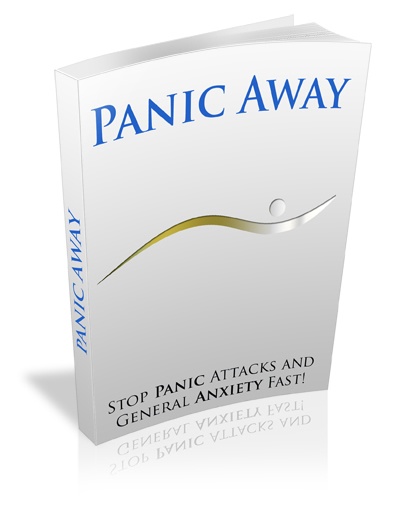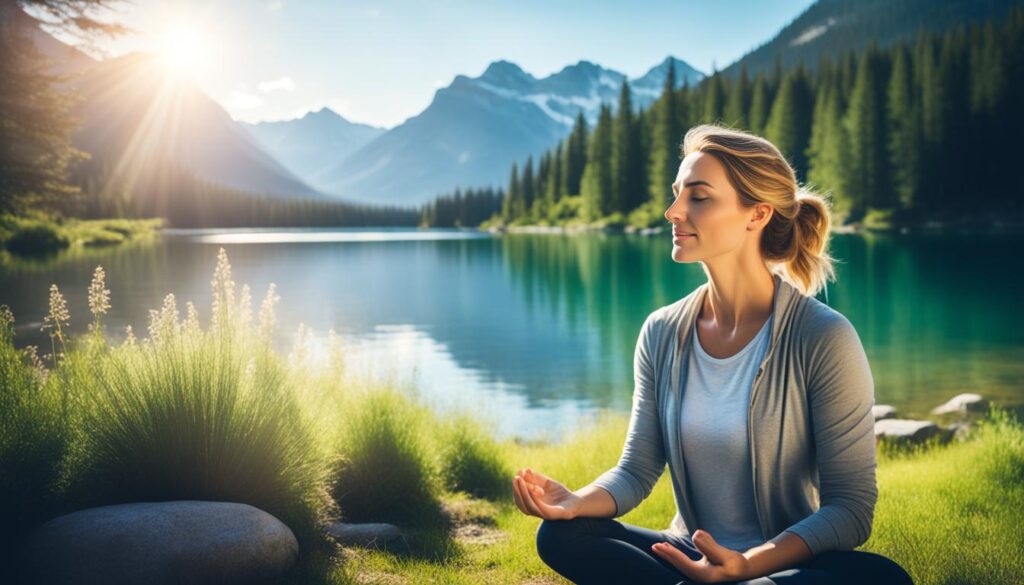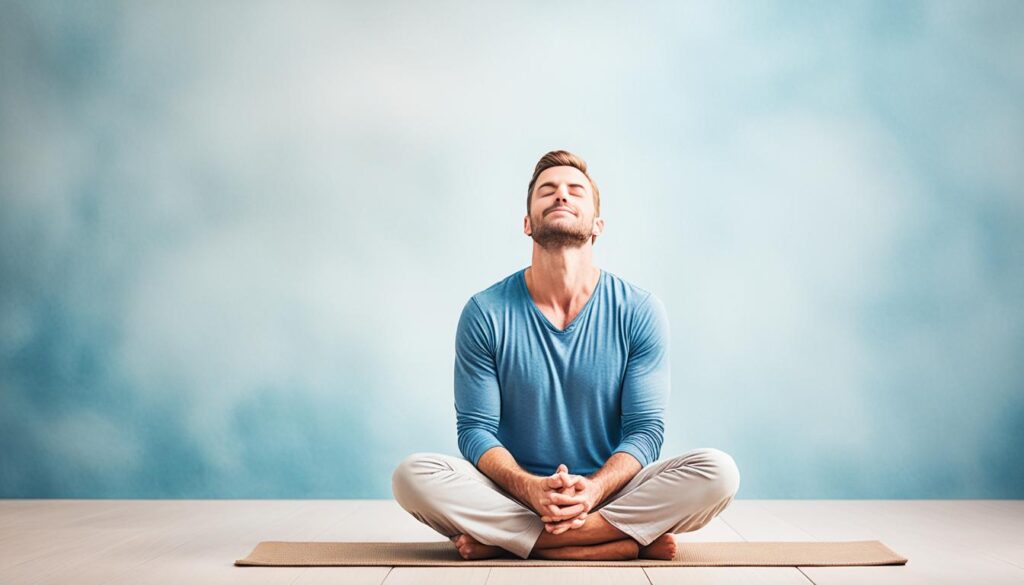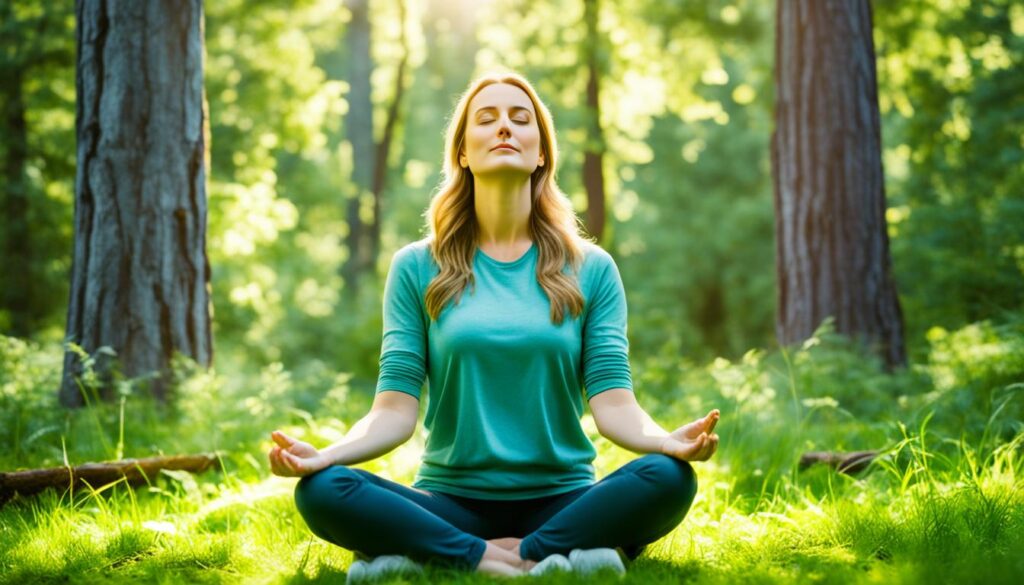Have you ever found yourself consumed by anxiety, unable to find a moment of peace? I know that feeling all too well. The weight of worry, the restlessness that keeps you up at night, the constant tension in your muscles – it can be overwhelming. But I'm here to tell you that there is hope.
Meditation has been a game-changer for me when it comes to anxiety control. It's not some new-age fad or a quick fix; it's a scientifically proven method to reduce anxiety and regain tranquility. By incorporating different meditation techniques into my daily routine, I've found a way to manage and control my anxiety levels.
Our Top Pick For Beating Panic Attacks

Stopping, and preventing, panic attacks is now even easier.
Key Takeaways:
- Meditation can effectively reduce anxiety and its symptoms.
- It activates the brain's relaxation response and increases feel-good chemicals.
- Mindfulness, loving-kindness, body scan, guided meditation, and breathing exercises are some of the techniques that can help manage anxiety.
- Consistency and patience are key in establishing a regular meditation routine.
- Incorporating meditation into your daily life can lead to increased mindfulness, relaxation, and overall well-being.
Understanding Anxiety and Its Effects on the Mind and Body
Anxiety is a common mental health condition that can have significant impacts on both the mind and body. It is characterized by a range of symptoms, including excessive worry, restlessness, lack of concentration, muscle tension, racing heart, nausea, and fatigue. These symptoms can vary in intensity and duration, but they often interfere with daily life and overall well-being.
Anxiety can affect the mind by causing excessive and uncontrollable thoughts, leading to feelings of overwhelm and difficulty concentrating. It can also give rise to negative thinking patterns, causing individuals to anticipate the worst outcome in various situations. Moreover, anxiety can exacerbate feelings of stress and make it challenging to relax and find inner calmness.
The physical effects of anxiety can be equally distressing. Muscle tension is a common physical symptom, as anxiety triggers the body's stress response, causing muscles to tighten. This tension can lead to headaches, backaches, and other musculoskeletal discomfort. Additionally, anxiety can manifest as a racing heart, shallow breathing, stomachaches, and digestive issues. Fatigue is another prevalent physical effect, as the body's heightened state of arousal can interfere with quality sleep.
Excessive worry, restlessness, lack of concentration, muscle tension, racing heart, nausea, and fatigue are all symptoms of anxiety that can significantly impact daily life.
Recognizing the symptoms of anxiety is crucial for seeking appropriate support and care. It is essential to understand that anxiety is not merely a passing worry or nervousness but a legitimate mental health condition that requires attention and management.
The Impact of Anxiety Disorders
If left unaddressed, anxiety can lead to various anxiety disorders, such as Generalized Anxiety Disorder (GAD). GAD involves persistent and excessive worry about multiple areas of life, lasting for six months or more. These worries are often unrealistic or disproportionate to the actual circumstances, causing distress and impairing daily functioning.
Other anxiety disorders include panic disorder, social anxiety disorder, specific phobias, and post-traumatic stress disorder (PTSD). Each of these disorders has its unique symptoms and impact on individuals' lives, but they all share the common thread of anxiety as a central feature.
Understanding the mental and physical effects of anxiety is a crucial step in managing this condition effectively. By recognizing and addressing anxiety symptoms, individuals can take proactive steps towards finding appropriate support and developing strategies to regain control over their mental and physical well-being.
The Science behind Meditation and Anxiety Reduction
When it comes to understanding how meditation helps reduce anxiety, it's important to delve into the science behind it. Through various mechanisms, meditation has a profound impact on our brain and body, leading to reduced anxiety levels and increased emotional well-being.
The Amygdala: Calming the Brain's Alarm System
One key component of meditation's anxiety-reducing effects lies in its ability to calm the amygdala. The amygdala is the brain's alarm system that triggers the stress response when it perceives a threat. During periods of anxiety, the amygdala becomes overactive, leading to heightened feelings of fear and worry.
By regularly practicing meditation, we can effectively quiet the amygdala, decreasing its reactivity and diminishing the anxiety response. This allows us to approach stressful situations with a greater sense of calm and clarity.
The Relaxation Response: Activating the Body's Natural Restorative Process
Meditation also activates the relaxation response, which is the body's natural counterbalance to the stress response. When we experience anxiety, our bodies go into a state of heightened arousal, releasing stress hormones and preparing us for fight or flight.
Through meditation, we elicit the relaxation response, effectively dampening the stress response. This leads to a cascade of physical and mental changes, including lowered heart rate, reduced blood pressure, and a general sense of calm and tranquility. The relaxation response helps counteract the physiological effects of anxiety, promoting relaxation and restoring balance to both our mind and body.
Feel-Good Chemicals: Enhancing Emotional Well-being
Another fascinating aspect of meditation's impact on anxiety is its ability to increase the production of feel-good chemicals in our brain. When we meditate, we stimulate the release of neurotransmitters such as serotonin and endorphins.
Serotonin is a neurotransmitter that helps regulate mood, promoting feelings of happiness and well-being. Endorphins, on the other hand, are our body's natural painkillers and mood boosters. By increasing the levels of these feel-good chemicals, meditation helps improve our emotional resilience, making it easier for us to cope with stress and anxiety.

Meditation is a powerful tool for anxiety reduction, addressing both the psychological and physiological aspects of anxiety. By calming the amygdala, activating the relaxation response, and boosting feel-good chemicals, meditation enhances our ability to manage stress and respond calmly to challenging situations. Incorporating meditation into our daily routine can promote emotional well-being and lead to a greater sense of peace and tranquility in our lives.
Mindfulness Meditation for Anxiety Control
Mindfulness meditation is a powerful technique for anxiety control that focuses on the present moment and cultivates a non-judgmental attitude. By actively observing anxious thoughts and feelings without getting entangled in them, individuals can gain a greater sense of clarity and calmness. Mindfulness meditation allows us to become more aware of our thoughts, emotions, and bodily sensations, helping to reduce anxiety and promote emotional well-being.
When practicing mindfulness meditation for anxiety control, I find that it's helpful to create a quiet and peaceful space where I can fully immerse myself in the practice. Sitting comfortably with my eyes closed, I bring my attention to my breath and tune in to the physical sensations of each inhalation and exhalation. Whenever my mind wanders, which it inevitably does, I gently guide my attention back to the present moment and the rhythm of my breath.
“Mindfulness meditation is the key to unlocking the present moment, where anxiety loses its grip.”
As I continue the practice, I become more aware of the thoughts and emotions that arise within me. Rather than judging or labeling them as good or bad, I simply observe them with acceptance and curiosity. This non-judgmental attitude allows me to create a space of compassion and understanding towards myself, which is essential for anxiety control.
The benefits of mindfulness meditation extend beyond the meditation cushion. With regular practice, I've noticed that I'm better able to navigate challenging situations with a greater sense of calmness and resilience. I'm less reactive to stressors and can respond thoughtfully rather than impulsively. Mindfulness meditation has truly changed the way I approach anxiety, allowing me to reclaim control over my own well-being.
To give you a clear picture of the benefits of mindfulness meditation, here's a comparison table:
| Mindfulness Meditation | Benefits |
|---|---|
| Reduces anxiety | By observing thoughts and emotions without getting caught up in them, mindfulness meditation helps reduce anxiety levels and promotes emotional well-being. |
| Promotes present moment awareness | Mindfulness meditation trains the mind to focus on the present moment, allowing individuals to fully engage in their experiences and find peace in the here and now. |
| Cultivates non-judgmental attitude | By adopting a non-judgmental attitude towards thoughts and emotions, mindfulness meditation promotes self-compassion and acceptance, reducing anxiety associated with self-criticism or rumination. |
| Enhances emotional regulation | Regular practice of mindfulness meditation strengthens the ability to regulate emotions, allowing individuals to respond to challenging situations with greater clarity and equanimity. |
By incorporating mindfulness meditation into your daily routine, you can actively manage anxiety and cultivate a sense of peace and well-being. Give it a try and experience the transformative power of mindfulness for yourself.
Loving-Kindness Meditation for Anxiety Reduction
Anxiety can often lead to feelings of isolation and disconnection from ourselves and others. Loving-kindness meditation offers a powerful practice for cultivating compassion, empathy, and reducing anxiety. By directing loving-kindness towards oneself and others, even those who may be challenging, this meditation technique promotes emotional balance and a sense of interconnectedness.
During loving-kindness meditation, I focus my attention on cultivating feelings of compassion and love. I begin by sitting in a comfortable position, closing my eyes, and taking a few deep breaths to center myself. I imagine a person or a group of people who I feel compassion towards, such as a loved one or a close friend. I then repeat a series of phrases silently in my mind:
May you be happy. May you be safe. May you be healthy. May you live with ease.
As I continue the meditation, I extend these phrases to myself:
May I be happy. May I be safe. May I be healthy. May I live with ease.
Next, I expand my circle of compassion to include all beings, near and far:
May all beings be happy. May all beings be safe. May all beings be healthy. May all beings live with ease.
This practice of extending loving-kindness towards oneself and others helps to shift the focus away from anxiety and towards a sense of interconnectedness and well-being. By intentionally cultivating compassion and empathy, loving-kindness meditation can reduce anxiety and promote emotional resilience.
Benefits of Loving-Kindness Meditation for Anxiety Reduction
Loving-kindness meditation offers several benefits for anxiety reduction:
- Promotes compassion: Practicing loving-kindness meditation helps to develop a compassionate mindset towards oneself and others. This compassion acts as a counterbalance to anxiety, fostering a sense of empathy and understanding.
- Reduces isolation: Anxiety can often make individuals feel isolated and disconnected from others. By directing loving-kindness towards all beings, this meditation practice promotes a sense of interconnectedness and belonging.
- Enhances emotional well-being: Cultivating feelings of love and kindness activates the brain's relaxation response and promotes emotional balance. This, in turn, reduces anxiety and enhances overall well-being.
Through loving-kindness meditation, I have experienced a significant reduction in anxiety and an increased sense of connection with myself and others. This practice has helped me cultivate empathy, compassion, and emotional resilience, allowing me to approach anxious situations with greater calm and understanding.

Body Scan Meditation for Stress and Anxiety Management
Body scan meditation is a powerful practice for managing stress and anxiety. It involves systematically scanning the body and bringing awareness to different body parts, promoting relaxation and grounding in the present moment.
During a body scan meditation, I start from the top of my head and gradually move down, observing any sensations or tension I may be holding in each area. By paying attention to these physical sensations, I am able to release tension and gain a deeper understanding of my body's needs.
By cultivating body awareness through regular body scan meditations, you can effectively manage stress and anxiety. This technique allows you to connect with your body and develop a more intuitive understanding of how stress manifests physically.
Through body scan meditation, you can:
- Identify areas of tension or discomfort in your body
- Release muscle tension and promote relaxation
- Anchors your mind in the present moment
- Cultivate body awareness and understanding
By bringing attention and kindness to each part of your body, you create a sense of calm and relaxation that can greatly benefit your overall well-being. Incorporating body scan meditation into your stress and anxiety management routine can provide you with a valuable tool for self-care.
“Body scan meditation helps me develop a deeper connection with my body and understand how stress affects me physically. By nurturing this awareness, I can release tension and find a greater sense of peace and tranquility.”
Guided Meditation for Anxiety Relief
When it comes to finding relief from anxiety and achieving a state of relaxation and mindfulness, guided meditation can be a wonderful tool. Guided meditation is a structured form of meditation where an instructor or recording guides individuals through specific relaxation and mindfulness exercises. It is particularly beneficial for beginners who may find it challenging to navigate meditation on their own.
Guided meditations often incorporate elements from various meditation techniques, making them versatile and effective in providing anxiety relief. The instructor's voice acts as a reassuring presence, offering support and direction throughout the meditation session. This guidance helps individuals stay focused, engaged, and present in the moment, enhancing the overall meditation experience.
By following the instructions of a skilled guide, individuals can cultivate a deeper sense of relaxation, peace, and mindfulness. They can develop skills to deal with anxious thoughts and emotions, allowing them to find relief from anxiety and regain a sense of calmness and tranquility.
Guided meditations can be found through various resources such as meditation apps, online platforms, or even in-person classes and workshops. These resources offer a wide range of guided meditation sessions tailored to different needs and preferences, including sessions specifically designed for anxiety relief.
One of the advantages of guided meditation is its accessibility. It can be done at any time and in any place, making it a flexible tool for individuals seeking anxiety relief. Whether it's a few minutes during a break at work or a longer session in the comfort of your home, guided meditation allows you to carve out dedicated time for self-care and mental well-being.
Moreover, guided meditation can be easily incorporated into a daily routine, ensuring consistent practice and long-term benefits for anxiety relief. By making it a habit, individuals can strengthen their meditation practice and create a positive impact on their overall mental health.
Benefits of Guided Meditation for Anxiety Relief:
- Promotes relaxation and reduces stress
- Enhances mindfulness and present-moment awareness
- Helps to quiet and calm the mind
- Assists in observing and managing anxious thoughts and emotions
- Cultivates a sense of focus and clarity
With its structured guidance and emphasis on relaxation and mindfulness, guided meditation offers a powerful and effective way to find relief from anxiety. By incorporating guided meditations into your routine, you can experience the transformative benefits of this practice and create a lasting sense of peace and well-being.
“Guided meditation offers a supportive and reassuring presence, guiding individuals through relaxation and mindfulness exercises, providing anxiety relief and promoting a state of relaxation and mindfulness.”
Now that we have explored the benefits of guided meditation for anxiety relief, let's move on to breathing exercises as another effective tool for calming the mind and body.

Breathing Exercises for Calming the Mind and Body
When anxiety strikes, deep breathing exercises can be a powerful tool to regain control and restore calmness to both the mind and body. By focusing on the breath and engaging in deep, controlled breathing, individuals can activate the body's relaxation response, effectively reducing feelings of stress and anxiety.
Deep breathing exercises can be done anywhere and at any time, making them a convenient technique for anxiety control. Whether you're at home, work, or in a crowded space, taking a few moments to focus on your breath can make a significant difference in your overall well-being.
How to Practice Deep Breathing Exercises
- Find a comfortable position: Sit or lie down in a position that allows you to relax your body completely.
- Close your eyes: Closing your eyes helps you detach from external distractions and better focus on your breath.
- Place one hand on your chest and the other on your abdomen: This helps you become more aware of the movement of your breath.
- Inhale deeply through your nose: Take a slow, deep breath in, feeling your abdomen rise as you fill your lungs with air.
- Exhale slowly through your mouth: Release your breath slowly, feeling your abdomen fall as you expel the air from your lungs.
- Repeat this process: Continue inhaling deeply through your nose and exhaling slowly through your mouth for several minutes, focusing on each breath.
During deep breathing exercises, it's crucial to pay attention to the sensation of your breath entering and leaving your body. By directing your focus solely on your breath, you're able to shift your attention away from worrisome thoughts and into a state of relaxation and calmness.
“Breathing in, I calm body and mind. Breathing out, I smile. Dwelling in the present moment, I know this is the only moment.”

Practicing deep breathing exercises regularly can help you build resilience and respond effectively to stressful situations. Incorporating them into your daily routine is a simple yet effective way to reduce anxiety levels and promote relaxation and well-being.
Progressive Muscle Relaxation for Anxiety Management
Anxiety can take a toll on both our physical and mental well-being, causing tension and discomfort. To effectively manage anxiety, it's crucial to find techniques that promote relaxation and release the built-up tension. One such technique is progressive muscle relaxation.
Progressive muscle relaxation involves systematically tensing and relaxing different muscle groups throughout the body, promoting physical and mental relaxation. By increasing awareness of physical sensations and redirecting attention away from anxious thoughts, this technique can effectively manage anxiety.
To practice progressive muscle relaxation, follow these steps:
- Find a quiet and comfortable space: Choose a location where you can relax without distractions.
- Get into a relaxed position: Sit or lie down in a comfortable position, ensuring that your body feels supported.
- Focus on your breath: Take a few deep breaths, inhaling deeply through your nose and exhaling slowly through your mouth. Allow yourself to begin to relax.
- Tense and release: Start at one end of your body, such as your feet or hands. Tense the muscles in that area for about 5-10 seconds, then release the tension and allow the muscles to fully relax.
- Move to the next muscle group: Gradually work your way up or down your body, tensing and releasing different muscle groups. Examples of muscle groups to focus on include your calves, thighs, abdominal muscles, shoulders, neck, and forehead.
- Pay attention to the sensations: As you tense and release each muscle group, pay close attention to the sensations you feel. Notice the contrast between tension and relaxation.
- Continue for about 10-15 minutes: Repeat the process of tensing and releasing each muscle group for about 10-15 minutes, or until you feel a sense of deep relaxation.
Progressive muscle relaxation can be a powerful tool for anxiety management as it helps to relax the body, allowing the mind to slow down and find tranquility. By incorporating this technique into your routine, you can release tension and promote a sense of calm.
Remember, consistent practice is key to experiencing the full benefits of progressive muscle relaxation. Find a time that works best for you, whether it's in the morning, during a break, or before bed, and make it a regular part of your anxiety management routine.

Practice progressive muscle relaxation regularly, and you'll be amazed at how it can effectively manage anxiety, promote tension release, and bring about deep relaxation. Give it a try, and experience the transformative power of this technique in your own life.
Creating a Routine and Overcoming Challenges in Meditation Practice
Building a regular meditation routine is essential for long-term anxiety control. Consistency is key in establishing a daily practice that becomes a habit. Even starting with short meditation sessions can have significant benefits. Gradually increase the duration of your practice as you become more comfortable.
However, it's important to acknowledge that challenges may arise during the meditation journey. Wandering thoughts and expectations are common obstacles that can disrupt focus and discourage progress. Remember, these challenges are part of the process, and it's normal to experience them.
To overcome these challenges, create a supportive meditative environment. Find a quiet and comfortable space where you can immerse yourself in the practice without distractions. Experiment with different meditation techniques and find the ones that resonate with you the most. Whether it's mindfulness meditation, loving-kindness meditation, or body scan meditation, choose the practices that suit your needs and preferences.
Patience is key as you develop your meditation routine. Understand that consistency and perseverance are crucial in reaping the long-term benefits. Don't be too hard on yourself if your mind wanders or if you miss a day of practice. Forgive yourself and come back to the practice with renewed commitment.
Remember, meditation is not about achieving perfection or reaching a specific goal. It's about cultivating a sense of presence, awareness, and inner peace. Embrace the journey, enjoy the process, and let go of any self-judgment.
Benefits of a Meditation Routine
A consistent and daily meditation practice offers numerous benefits for anxiety control and overall well-being:
- Reduces stress and promotes relaxation
- Enhances emotional resilience and self-awareness
- Improves focus, concentration, and cognitive function
- Boosts mood and reduces negative emotions
- Increases mindfulness and present-moment awareness
By incorporating meditation into your daily routine and overcoming the challenges that arise, you can experience these transformative benefits.

| Meditation Routine Tips | Overcoming Meditation Challenges |
|---|---|
| 1. Set a specific time for meditation each day. | 1. Don't judge yourself for wandering thoughts. |
| 2. Create a designated meditation space. | 2. Embrace imperfections in your practice. |
| 3. Start with shorter sessions and gradually increase the duration. | 3. Let go of expectations and be present in the moment. |
| 4. Find a meditation technique that resonates with you. | 4. Surround yourself with a supportive community or teacher. |
| 5. Use guided meditations or apps for guidance. | 5. Practice self-compassion and forgive missed sessions. |
Remember, consistency and patience are key in establishing a meditation routine. Embrace the challenges as learning opportunities and stay committed to your practice. Over time, you'll witness the transformative effects of meditation on your anxiety levels and overall well-being.
Conclusion
In conclusion, incorporating meditation techniques into your daily routine can be a powerful way to control anxiety and promote overall well-being. Mindfulness meditation, loving-kindness meditation, body scan meditation, guided meditation, breathing exercises, and progressive muscle relaxation are all effective techniques for managing anxiety. By practicing consistency and dedicating time each day to these techniques, you can experience increased mindfulness and relaxation.
Mindfulness meditation allows you to focus on the present moment and observe your thoughts and feelings without judgment. Loving-kindness meditation helps cultivate compassion and empathy, reducing anxiety and feelings of isolation. Body scan meditation brings awareness to your physical sensations, helping you release tension and find calm. Guided meditation provides structure and support, making it a great option for beginners. Breathing exercises and progressive muscle relaxation help calm the mind and relax the body, reducing stress and anxiety.
By incorporating these meditation techniques into your routine and practicing them consistently, you can build resilience and effectively manage anxiety. Make meditation a daily habit, even if it starts with just a few minutes a day. Over time, you will experience the benefits of increased mindfulness, relaxation, and emotional well-being. Start your meditation journey today and take control of your anxiety.
FAQ
How can meditation techniques help with anxiety control?
Meditation techniques activate the brain's relaxation response, increase feel-good chemicals, and enhance emotional resilience, effectively reducing anxiety and its symptoms.
What are the mental and physical effects of anxiety?
Anxiety can manifest as excessive worry, restlessness, lack of concentration, muscle tension, racing heart, nausea, and fatigue, impacting both the mind and body.
How does mindfulness meditation help in anxiety control?
Mindfulness meditation involves focusing on the present moment with a non-judgmental attitude, allowing individuals to observe anxious thoughts and feelings without getting caught up in them, thus reducing anxiety and promoting emotional well-being.
How does loving-kindness meditation reduce anxiety?
Loving-kindness meditation involves cultivating compassion and love towards oneself and others, even those who are challenging. By promoting empathy and kindness, it can reduce anxiety and feelings of isolation, leading to emotional balance.
What is body scan meditation and how does it manage stress and anxiety?
Body scan meditation involves systematically scanning the body and focusing on different body parts to bring awareness and relaxation. By tuning into physical sensations and releasing tension, it effectively manages stress and anxiety.
What is guided meditation and how does it provide anxiety relief?
Guided meditation is a structured form of meditation where an instructor or recording guides individuals through relaxation and mindfulness exercises. It provides support and direction, incorporating elements of different meditation techniques to relieve anxiety and promote relaxation.
How do breathing exercises help calm the mind and body during anxiety?
By focusing on the breath and practicing deep, controlled breathing, breathing exercises activate the body's relaxation response, reducing stress and anxiety. They can be done anywhere and anytime, making them a convenient tool for anxiety control.
What is progressive muscle relaxation and how does it help manage anxiety?
Progressive muscle relaxation involves tensing and relaxing different muscle groups to release physical and mental tension. By increasing awareness of physical sensations and diverting attention from anxious thoughts, it effectively manages anxiety and promotes relaxation.
How can I create a meditation routine and overcome challenges?
Building a regular meditation routine is important for long-term anxiety control. It is essential to start with short sessions and gradually increase the duration. Overcoming challenges, such as wandering thoughts and expectations, is part of the meditation journey. Creating a supportive environment and being patient with oneself are crucial in making meditation a habit.
Are there any specific meditation techniques that can help with anxiety control?
Yes, mindfulness meditation, loving-kindness meditation, body scan meditation, guided meditation, breathing exercises, and progressive muscle relaxation are all effective techniques for managing anxiety. Incorporating these techniques into a daily routine and practicing consistency can increase mindfulness, relaxation, and overall well-being.


